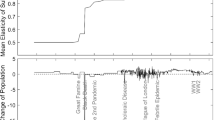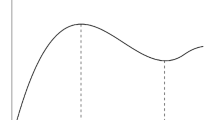Abstract
This study develops a scale-invariant Schumpeterian growth model with endogenous fertility and human capital accumulation. The model features two engines of long-run economic growth: R&D-based innovation and human capital accumulation. One novelty of this study is endogenous fertility, which negatively affects the growth rate of human capital. Given this growth-theoretic framework, we characterize the dynamics of the model and derive comparative statics of the equilibrium growth rates with respect to structural parameters. As for policy implications, we analyze how patent policy affects economic growth through technological progress, human capital accumulation, and endogenous fertility. In summary, we find that strengthening patent protection has (a) a positive effect on technological progress, (b) a negative effect on human capital accumulation through a higher rate of fertility, and (c) an ambiguous overall effect on economic growth.
Similar content being viewed by others
Notes
See Jones (1999) for an excellent review of these subsequent generations of R&D-based growth models.
See, for example, Strulik (2005) for a discussion.
See also Barro and Becker (1989) for a seminal study on endogenous fertility in an overlapping-generation model with exogenous growth.
See also Jones (2003), who analyzes the effects of an exogenous increase in the R&D share of labor chosen by the government. He finds that this policy change increases growth in the short run but decreases growth in the long run through a lower rate of fertility due to a crowding-out effect on labor supply. In contrast, our result of a negative effect of patent breadth on economic growth is based on a higher rate of fertility through an opportunity-cost effect of lower foregone wages.
See Scotchmer (2004) for a comprehensive review of this patent-design literature.
See also Horowitz and Lai (1996).
See Growiec (2006) for an interesting discussion on alternative ways of modeling endogenous fertility in the growth literature.
We follow a common approach in the literature to assume that θ is independent of capital accumulation or technological progress; see also Yip and Zhang (1997) and Connolly and Peretto (2003). Otherwise, as technology or human capital accumulates, θ increases causing a lower time cost of fertility, which in turn leads to a rising fertility rate instead of a constant fertility rate (i.e., ruling out a balanced growth path). However, we think it is reasonable that parental human capital contributes to the health and education of children, and this positive effect is captured by the law of motion for human capital per capita in Eq. 4.
This is known as the Arrow replacement effect in the literature. See Cozzi (2007) for a discussion on the Arrow effect.
We follow the standard approach in the literature to focus on the symmetric equilibrium. See Cozzi et al. (2007) for a theoretical justification for the symmetric equilibrium to be the unique rational-expectation equilibrium in the quality-ladder growth model.
In an earlier version of this study, see Chu and Cozzi (2011), we consider a semi-endogenous-growth version of the model by specifying \(\overline{\varphi }_{t}\) to be decreasing in aggregate technology. In that model, we find that patent breadth has the same effects on fertility as in the current framework. However, the current framework is more general because long-run growth depends also on the R&D share of human capital whereas this R&D share only plays a role on short-run growth, but not on long-run growth in the semi-endogenous growth model.
We assume constant returns to scale at the firm level in order to be consistent with free entry and zero expected profit.
It is useful to recall that a t = v t /N t .
See Appendix B (available online) for derivations.
See footnote 20 for a discussion.
To see this, differentiating Eq. 23 with respect to ξ yields \(\partial g_{h}/\partial \xi =(1-n/\theta )-(1+\xi /\theta )\partial n/\partial \xi >0\) . Recall that 1 − n/θ > 0 and \(\partial n/\partial \xi <0\).
In the special case of ϕ = 1, it can be shown that patent breadth μ has no effect on the fertility rate n ∗ leaving only the positive effect on \(s_{r}^{\ast }\).
In an extension of their model with human capital, Futagami and Iwaisako (2007) find that increasing patent length has a negative effect on the wage rate and human capital accumulation via an alternative mechanism other than endogenous fertility.
Jones and Williams (2000) consider a lower bound for ϕ to be about 0.5 based on empirical estimates for the social rate of return to R&D. In this study, we intentionally choose a small value for ϕ in order for TFP growth g z not to be overly responsive to the R&D share of GDP. In our calibration, the elasticity of TFP growth with respect to the R&D share of GDP is about 0.2. If we set ϕ to a higher value of 0.5, the elasticity increases to about 0.5. However, while R&D share of GDP in the USA has been steadily rising, TFP growth shows no significant upward trend.
Persons in households with older children spend even less time for child caring.
We would like to thank a referee for suggesting this interesting extension.
References
Aghion P, Howitt P (1992) A model of growth through creative destruction. Econometrica 60:323–351
Barro R, Becker G (1989) Fertility choice in a model of economic growth. Econometrica 57:481–501
Bessen J, Meurer M (2008) Patent failure: how judges, bureaucrats, and lawyers put innovators at risk. Princeton University Press, Princeton
Boldrin M, Levine D (2008) Against intellectual monopoly. Cambridge University Press, Cambridge
Chu A (2009) Effects of blocking patents on R&D: a quantitative DGE analysis. J Econ Growth 14:55–78
Chu A, Cozzi G (2011) Cultural preference on fertility and the long-run growth effects of intellectual property rights. MPRA Papers No 29059
Chu A, Cozzi G, Galli S (2012) Does intellectual monopoly stimulate or stifle innovation? Eur Econ Rev 56:727–746
Connolly M, Peretto P (2003) Industry and the family: two engines of growth. J Econ Growth 8:115–148
Cozzi G (2001) Inventing or spying? Implications for growth. J Econ Growth 6:55–77
Cozzi G (2007) The Arrow effect under competitive R&D. Contrib Macroecon 7:Article 2
Cozzi G, Giordani P, Zamparelli L (2007) The refoundation of the symmetric equilibrium in Schumpeterian growth models. J Econ Theory 136:788–797
Cozzi G, Spinesi L (2006) Intellectual appropriability, product differentiation, and growth. Macroecon Dyn 10:39–55
Cysne R, Turchick D (2012) Intellectual property rights protection and endogenous economic growth revisited. J Econ Dyn Control 36:851–861
Davis L, Sener F (2012) Private patent protection in the theory of Schumpeterian growth. Manuscript, Union College
Dinopoulos E, Syropoulos C (2007) Rent protection as a barrier to innovation and growth. Econ Theory 32:309–332
Dinopoulos E, Thompson P (1998) Schumpeterian growth without scale effects. J Econ Growth 3:313–335
Furukawa Y (2007) The protection of intellectual property rights and endogenous growth: is stronger always better? J Econ Dyn Control 31:3644–3670
Furukawa Y (2010) Intellectual property protection and innovation: an inverted-U relationship. Econ Lett 109:99–101
Futagami K, Iwaisako T (2007) Dynamic analysis of patent policy in an endogenous growth model. J Econ Theory 132:306–334
Gilbert R, Shapiro C (1990) Optimal patent length and breadth. RAND J Econ 21:106–112
Grossman G, Helpman E (1991) Quality ladders in the theory of growth. Rev Econ Stud 58:43–61
Growiec J (2006) Fertility choice and semi-endogenous growth: where Becker meets Jones. Top Macroecon 6:Article 10
Ha J, Howitt P (2007) Accounting for trends in productivity and R&D: a Schumpeterian critique of semi-endogenous growth theory. J Money Credit Bank 39:733–774
Horii R, Iwaisako T (2007) Economic growth with imperfect protection of intellectual property rights. J Econ 90:45–85
Horowitz A, Lai E (1996) Patent length and the rate of innovation. Int Econ Rev 37:785–801
Iwaisako T, Futagami K (2003) Patent policy in an endogenous growth model. J Econ 78:239–258
Iwaisako T, Futagami K (2011) Patent protection, capital accumulation, and economic growth. Econ Theory. doi:10.1007/s00199-011-0658-y
Jaffe A, Lerner J (2004) Innovation and its discontents: how our broken system is endangering innovation and progress, and what to do about it. Princeton University Press, Princeton
Jones C (1995) R&D-based models of economic growth. J Polit Econ 103:759–784
Jones C (1999) Growth: with or without scale effects. Am Econ Rev 89:139–144
Jones C (2001) Was an industrial revolution inevitable? Economic growth over the very long run. Adv Macroecon 1:Article 1
Jones C (2003) Population and ideas: a theory of endogenous growth. In: Aghion P, Frydman R, Stiglitz J, Woodford M (eds) Knowledge, information, and expectations in modern macroeconomics: in honor of Edmund S. Phelps. Princeton University Press, Princeton
Jones C, Williams J (2000) Too much of a good thing? The economics of investment in R&D. J Econ Growth 5:65–85
Judd K (1985) On the performance of patents. Econometrica 53:567–586
Kortum S (1992) Inventions, R&D and industry growth. Ph.D. Dissertation, Yale University
Kortum S (1997) Research, patenting, and technological change. Econometrica 65:1389–1419
Kwan Y, Lai E (2003) Intellectual property rights protection and endogenous economic growth. J Econ Dyn Control 27:853–873
Laincz C, Peretto P (2006) Scale effects in endogenous growth theory: an error of aggregation not specification. J Econ Growth 11:263–288
Laitner J, Stolyarov D (2011) Derivative ideas and the value of intangible assets. Manuscript, University of Michigan
Li CW (2001) On the policy implications of endogenous technological progress. Econ J 111:C164–C179
Nordhaus W (1969) Invention, growth, and welfare: a theoretical treatment of technological change. The MIT Press, Cambridge
O’Donoghue T, Zweimuller J (2004) Patents in a model of endogenous growth. J Econ Growth 9:81–123
Peretto P (1998) Technological change and population growth. J Econ Growth 3:283–311
Razin A, Ben-Zion U (1975) An intergenerational model of population growth. Am Econ Rev 65:923–933
Romer P (1990) Endogenous technological change. J Polit Econ 98:S71–S102
Scotchmer S (2004) Innovation and incentives. MIT Press, Cambridge
Segerstrom P (1998) Endogenous growth without scale effects. Am Econ Rev 88:1290–1310
Stokey N, Rebelo S (1995) Growth effects of flat-rate taxes. J Polit Econ 103:619–550
Strulik H (2005) The role of human capital and population growth in R&D-based models of economic growth. Rev Int Econ 13:129–145
Yip C, Zhang J (1997) A simple endogenous growth model with endogenous fertility: indeterminacy and uniqueness. J Popul Econ 10:97–110
Young A (1998) Growth without scale effects. J Polit Econ 106:41–63
Acknowledgements
The authors would like to thank Silvia Galli, Oded Galor, and the anonymous referees for their insightful comments and helpful suggestions. The usual disclaimer applies.
Author information
Authors and Affiliations
Corresponding author
Additional information
Responsible editor: Alessandro Cigno
Electronic Supplementary Material
Below is the link to the electronic supplementary material.
Rights and permissions
About this article
Cite this article
Chu, A.C., Cozzi, G. & Liao, CH. Endogenous fertility and human capital in a Schumpeterian growth model. J Popul Econ 26, 181–202 (2013). https://doi.org/10.1007/s00148-012-0433-9
Received:
Accepted:
Published:
Issue Date:
DOI: https://doi.org/10.1007/s00148-012-0433-9




